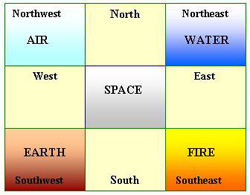What is ‘vastu shastra’?
As we have discussed in an earlier article here, ‘vastu shastra’ is an ancient Hindu system of architecture. The term ‘vastu’ means architecture and ‘shastra’ means science. Hence ‘vastu shastra’ is the science of architecture. It deals with the measurement, designs and development of structures in accordance with laws that bring harmony between humans and their natural habitat.
Main Elements of ‘vastu shastra’
Vastu shastra is the science of directions. It takes into account the five elements of the universe (earth, water, fire, air, and space) and combines them with the knowledge of directions to create harmonious structures. Hence, the two main elements of vastu shastra are directions and the natural elements.

- The Five Elements
The earth is the element that exudes maximum energy. Hence, vastu experts claim that it is important to consult before purchasing a piece of land. It requires inspection of soil, the shape and size of the land among other things before a vastu expert can tell if the land is auspicious or not.
The second element, water, is present in enormous amounts on earth. According to vastu shastra, proper placement of water sources is important. It is said that water should be kept in north-east as it is considered good for the health of the family. Due to this, vastu compliant houses will have drinking water taps, swimming pools and water tanks in the north-east direction.
The third element is fire. It is considered to be an element for the south-east direction as it brings harmony in relationships. Hence all fire-related equipment like the gas stove or the electrical gadgets like microwave oven etc. should be kept in the south-east direction. Similarly, the sun is the most primal source of light energy. It is suggested that there should proper windows and ventilation in a house for sunlight to come in.
The fourth element is air. It is because of air or oxygen that living beings can breathe and survive. In addition to oxygen, air also consists of carbon dioxide and nitrogen which is important for plant life. In this way, air is a must for any human, animal or plant to survive on earth. It is considered to be an element belonging to the north-west direction. Placing your windows in this direction will make it possible to bring in fresh air. This also explains why vastu shastra gives importance to proper ventilation outlets in a house.
The fifth and final element is space. The atmosphere, the sky, the stars, planets all constitute the space around us. Vastu considers the space around us to be very critical to our being and therefore it is suggested to have some space in the centre of the house. In fact, all traditional Indian houses or public utility places consisted of a courtyard.
- Directions
As discussed above, directions play a highly decisive role in vastu shastra. They are important in order to create a harmonious energy flow. There are 4 main directions in vastu shastra. These are East, West, North, South and the 4 sub-directions called north-east, north-west, south-east and south-west. There are 2 other directions (akash and patal). The relevance of the directions is discussed below.

Directions and Their Relevance in ‘Vastu Shastra’
- North
North is considered as an auspicious direction. It is ruled by the Hindu God of Wealth – Kuber. This direction is the harbinger of prosperity and is ruled by the planet Buddh or Mercury. This direction should be kept open and free of weight. This is because it provides positive energy to the whole structure.
- South
It is traditionally considered to be a bad direction, but since it is a bank or storage of all good energy coming in from north, hence, south should be kept closed in order to bring prosperity. The God of this direction is ‘Yam’ or the God of death. The planet ruling it is Mars.
- East
This direction represents power and the God of this direction is Lord Indra. It is ruled by the powerful Sun. Since Sun is responsible for giving energy for life to grow on earth, this direction is also a direction of growth. Hence, it should be kept clean and open to avoid stagnation.
- West
West is the direction for stability. It is ruled by Lord Varun, the God of rains and fate. The ruling planet of West is Saturn. Since it is related to rains, it is advisable to avoid light and openings in this area.
- North-East
Ruled by Lord Shiva, this direction is represented by planet Brahaspati or Jupiter. This direction is good for scholarly pursuits. Since it is a very pious direction, toilets are considered inauspicious in this direction.
- North-West
Ruled by the Lord of air – Vayu dev, this direction is powered by wind. The planet Moon rules this direction and hence north-west is an unstable direction which can create great opportunities if used wisely and vice-versa.
- South-East
This direction is ruled by Agni dev, ruler of Fire and the planet representing it is Shukra or Venus. This direction is dedicated to works related to fire like cooking and placing electrical equipment like generators, refrigerators, boilers etc.
- South-West
Ruled by the demon Niriti, this direction is ruled by Rahu which is a shadow planet as per vedic astrology (Rahu and Ketu shadow planets are points of intersection of the paths of the Sun and the Moon as they travel). It is the strongest direction and shows the strong magnetic energies flowing in from the north-east direction. It can bring prosperity, health and confidence to the resident of the house when it is used correctly. Hence there should be a structure of high altitude in the house in the south-west direction.
- Akash
This direction is also known as sky or ‘urdhwa’ meaning skywards. It is divided into 7 parts on the basis of height.
- Patal
This direction is also known as ‘adharasta’ meaning downwards. It is divided into 7 parts depending on the depth.
Directions are the heart and soul of vastu shastra. By following the rules of direction, energy flow of a house can be maintained for optimum harmony.
Images source: Internet








